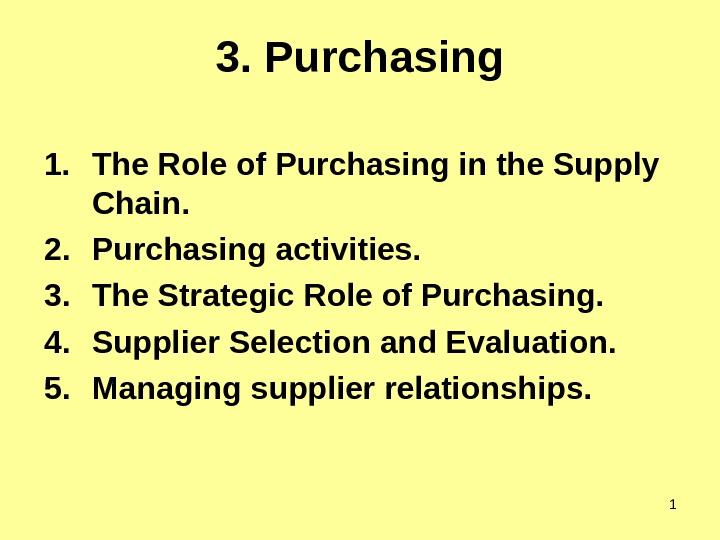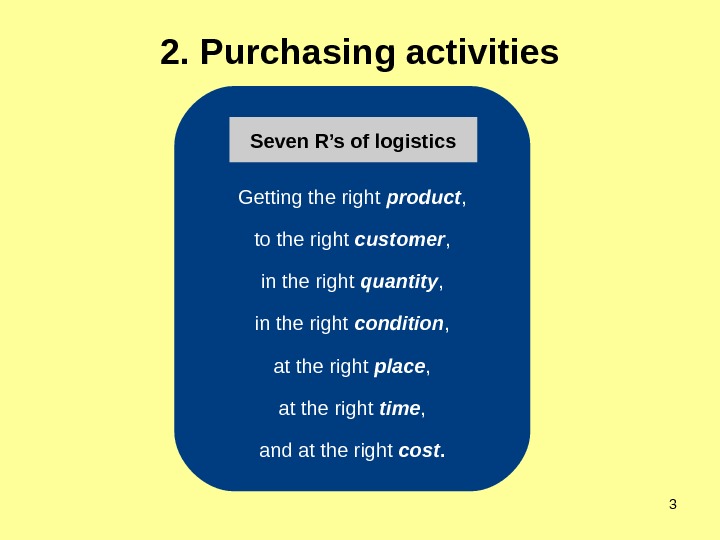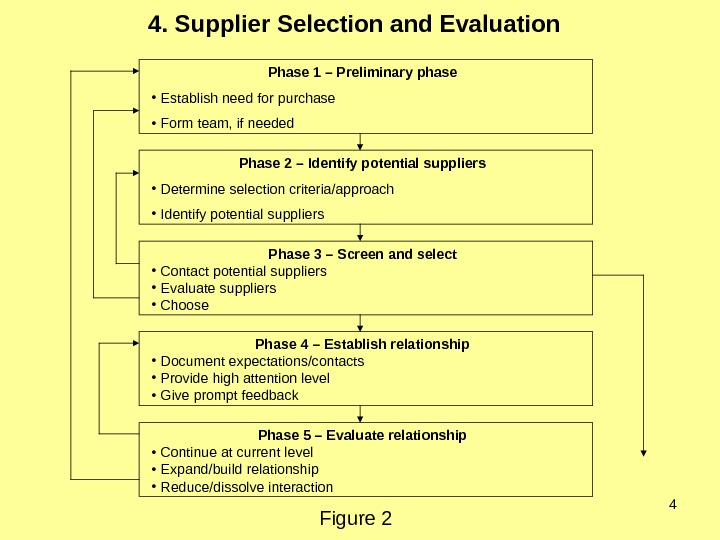13. Purchasing 1. The Role of Purchasing in






- Размер: 200 Кб
- Количество слайдов: 6
Описание презентации 13. Purchasing 1. The Role of Purchasing in по слайдам
 13. Purchasing 1. The Role of Purchasing in the Supply Chain. 2. Purchasing activities. 3. The Strategic Role of Purchasing. 4. Supplier Selection and Evaluation. 5. Managing supplier relationships.
13. Purchasing 1. The Role of Purchasing in the Supply Chain. 2. Purchasing activities. 3. The Strategic Role of Purchasing. 4. Supplier Selection and Evaluation. 5. Managing supplier relationships.
 21. The Role of Purchasing in the Supply Chain Figure 1 – Supply Chain Management K ey logistics processes Customer relationship management Customer service management Demand management Order fulfillment Manufacturing flow management Procurement Product development and commercialization Returns channel Performance metrics Materials management Production Physical distribution Marketing and sales Customer. Tier 2 supplier Tier 1 supplier Purchasing MRP MRP MPS DRP DRPProduct flow Information flow Just-in-time EDI Quick response. Logistics management
21. The Role of Purchasing in the Supply Chain Figure 1 – Supply Chain Management K ey logistics processes Customer relationship management Customer service management Demand management Order fulfillment Manufacturing flow management Procurement Product development and commercialization Returns channel Performance metrics Materials management Production Physical distribution Marketing and sales Customer. Tier 2 supplier Tier 1 supplier Purchasing MRP MRP MPS DRP DRPProduct flow Information flow Just-in-time EDI Quick response. Logistics management
 32. Purchasing activities Getting the right product , to the right customer , in the right quantity , in the right condition , at the right place , at the right time , and at the right cost. Seven R’s of logistics
32. Purchasing activities Getting the right product , to the right customer , in the right quantity , in the right condition , at the right place , at the right time , and at the right cost. Seven R’s of logistics
 44. Supplier Selection and Evaluation Figure 2 Phase 1 – Preliminary phase • Establish need for purchase • Form team, if needed Phase 2 – Identify potential suppliers • Determine selection criteria/approach • Identify potential suppliers Phase 3 – Screen and select • Contact potential suppliers • Evaluate suppliers • Choose Phase 4 – Establish relationship • Document expectations/contacts • Provide high attention level • Give prompt feedback Phase 5 – Evaluate relationship • Continue at current level • Expand/build relationship • Reduce/dissolve interaction
44. Supplier Selection and Evaluation Figure 2 Phase 1 – Preliminary phase • Establish need for purchase • Form team, if needed Phase 2 – Identify potential suppliers • Determine selection criteria/approach • Identify potential suppliers Phase 3 – Screen and select • Contact potential suppliers • Evaluate suppliers • Choose Phase 4 – Establish relationship • Document expectations/contacts • Provide high attention level • Give prompt feedback Phase 5 – Evaluate relationship • Continue at current level • Expand/build relationship • Reduce/dissolve interaction
 5 Table 1 — Evaluating Suppliers Factor Rating of supplier (1 = Worst rating, 5 = Highest rating) 1 2 3 4 5 Importance of factor to your firm (0 = No importance, 5 = Highest importance) 0 1 2 3 4 5 Weighted composite rating (0 = Minimum, 25 = Maximum) Supplier A Product reliability Price Ordering convenience … After-sale service Total for supplier A Supplier B Product reliability Price Ordering convenience … After-sale service Total for supplier B Supplier C Product reliability Price Ordering convenience … After-sale service Total for supplier
5 Table 1 — Evaluating Suppliers Factor Rating of supplier (1 = Worst rating, 5 = Highest rating) 1 2 3 4 5 Importance of factor to your firm (0 = No importance, 5 = Highest importance) 0 1 2 3 4 5 Weighted composite rating (0 = Minimum, 25 = Maximum) Supplier A Product reliability Price Ordering convenience … After-sale service Total for supplier A Supplier B Product reliability Price Ordering convenience … After-sale service Total for supplier B Supplier C Product reliability Price Ordering convenience … After-sale service Total for supplier
 65. Managing supplier relationships Figure 3 – Types of partnerships. Arm’s length Type II Type III Joint venture Vertical integration. Partnerships. A partnership is a tailored business relationship based on mutual trust, openness, shared risk and shared rewards that yields a competitive advantage, resulting in business performance greater than would be achieved by the firms individually.
65. Managing supplier relationships Figure 3 – Types of partnerships. Arm’s length Type II Type III Joint venture Vertical integration. Partnerships. A partnership is a tailored business relationship based on mutual trust, openness, shared risk and shared rewards that yields a competitive advantage, resulting in business performance greater than would be achieved by the firms individually.
